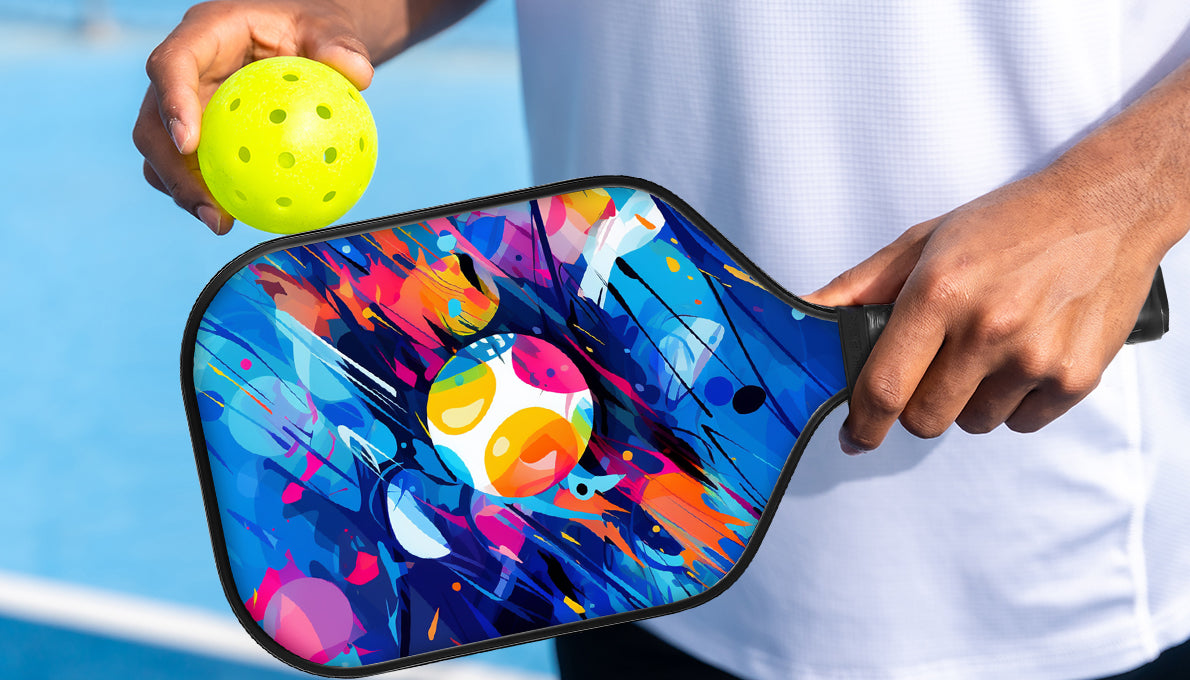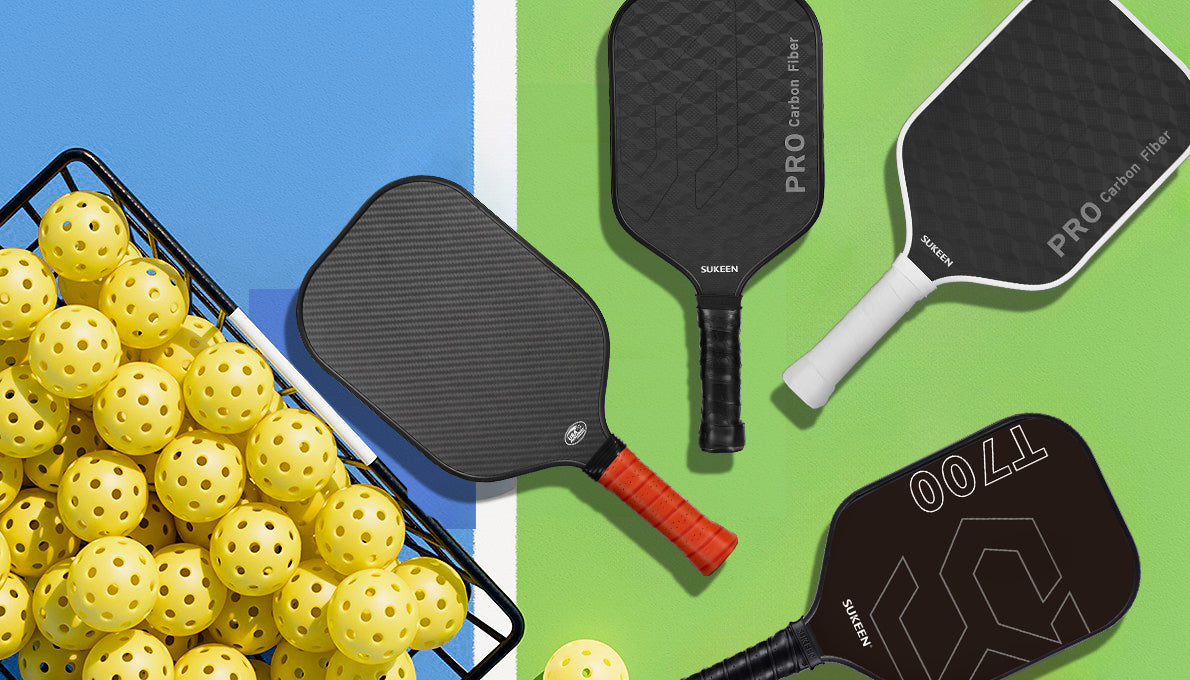Master the Secret of Spin Ball
I. Why Choose a Carbon Fiber Racket?II. Racket Surface Texture
III. How to hit the ball with perfect spin using a carbon fiber paddle
IV. Training suggestions for improving spin ball skills
V. Details of spin ball technology
As a senior pickleball coach, I understand the crucial role of a racket in executing effective spin techniques. Selecting a racket tailored for spin not only enhances your skills but also gives you a competitive edge. Today, I’ll be recommending SUKEEN’s carbon fiber series rackets and analyzing them from various professional angles to help you advance your spin game.
I. Why Choose a Carbon Fiber Racket?
Carbon fiber is prevalent in modern sports equipment due to its combination of lightweight and strength. In pickleball, carbon fiber rackets are not only easier to handle because of their reduced weight but also more durable, maintaining superior performance even during intense matches.
1. Increased Friction
Carbon fiber rackets are celebrated for their lightweight and robust properties. This material enhances control and feel, making it ideal for generating spin on the ball. The uniform and refined surface texture of carbon fiber effectively boosts spin control. When players strike the ball, the interaction between the ball and the carbon fiber surface is more stable, aiding in producing the desired spin through various techniques, such as chipping or pulling.
2. Precision and Stability
Carbon fiber provides a consistent racket response, allowing players to more accurately predict and control the ball's trajectory and spin, leading to greater stability and precision during play.
3. Improved Spin Control
The carbon fiber surface can be meticulously designed to increase the contact area between the ball and the racket, creating stronger friction. This enhanced friction helps players manage the ball’s movement and direction better, especially for complex techniques like spin and backspin.
The texture of a fiberglass racket can be rough or uneven due to its manufacturing process and material properties. While fiberglass can offer some friction, it may not match the spin control capabilities of carbon fiber. What is the best material for a pickleball paddle?
Many of my students use the SUKEEN carbon fiber series for spin techniques. These rackets provide excellent value and have undergone special treatments to significantly enhance spin effects. Whether executing forehand or backhand shots, you can easily achieve high-quality spin. The added friction from the carbon fiber surface allows precise control over the ball's rotation direction and speed. Carbon fiber’s durability ensures no deformation or wear over time, reducing the need for frequent replacements and saving costs. SUKEEN’s ergonomic grip design offers better comfort and reduces fatigue during extended play.
Experience top-notch performance and exceptional service at competitive prices. SUKEEN also offers customization services to cater to the unique needs of each player. "How to Customize a Pickleball Paddle? When it comes to the importance of customizing rackets, you can click to read and learn more about it.
II. Racket Surface Texture
The racket surface texture can vary, including mesh, dot, or scored patterns. These textures enhance friction between the ball and the racket surface, influencing the ball’s spin during impact.
1. Mesh Texture
Mesh textures, featuring fine grids or crosshatch lines, increase the contact area between the ball and racket surface. This design provides strong friction, making it easier to generate spin on shots like chipping or pulling. Mesh textures are ideal for players needing substantial rotation and precise control.
Application Scenarios
In competitive games with high technical demands, players can leverage mesh textures to enhance rotational control.
2. Dot Texture
Dot textures, evenly distributed on the racket surface, offer moderate friction. Although the contact area is smaller than mesh textures, it still provides sufficient control and spin for the ball.
Application Scenarios
Dot textures are suitable for players who seek a balance between basic control and rotational effect, making them versatile for various competition and training situations.
3. Scored Texture
Scored textures, characterized by deep lines or grooves, provide superior rotational control. These deep grooves enhance friction, allowing players to generate stronger spin on impact. This texture is ideal for technical players requiring robust spin control.
Application Scenarios
For advanced spin techniques like slices or backspin, scored textures help players control and adjust the ball's flight path more accurately.
4. Other Complex Textures
Some rackets feature intricate designs like waves or staggered ridges. These complex textures increase surface friction, offering excellent control and spin but may require a higher skill level to utilize effectively.If you want to know more about racket texture, you can read If you want to learn more about the texture of the paddle, you can read "Mastering Pickleball with Lead Tape".
5. Texture Depth
The depth of the texture affects the durability and effectiveness of spin. Deeper textures "catch" the ball better, creating more durable spin effects and influencing the ball’s trajectory more persistently. Choosing the right texture depth is crucial for consistent spin production.Click "How to Add Texture to the Pickleball Paddle?" to learn more related content.
6. Shooting Surface Area
The racket surface size impacts ball control and spin. A larger surface area offers more hitting space and fault tolerance, suitable for beginners. Conversely, a smaller surface area provides better control and spin for experienced players.
Large Racket Surface
A larger surface usually means a bigger sweet spot, offering more forgiveness on shots. However, it may require more technique to produce strong spin effects.
Small Surface Area
A smaller surface area concentrates power at the point of contact, increasing friction and spin efficiency. This is beneficial for precise control over spin, especially on slices or backspins.
7. Enhanced Rotation Control
A smaller racket surface area helps players control the ball's direction and spin more easily, allowing for precise adjustments to achieve stronger side spin or backspin effects, which can complicate opponents' predictions.
8. Border Design
The rigidity and stability of the racket frame affect vibration and deformation upon impact. Thicker and wider frame designs, such as oval or square cross-sections, increase rigidity and stability, reducing twisting and deformation, which enhances control and precision for spin shots.
Rigid and stable frames also incorporate vibration-absorbing technology, maintaining structural integrity and minimizing distortion.
9. Weight and Balance of the Racket
The weight and balance point impact ball spin significantly. A lighter racket facilitates fast swings and easier angle adjustments, enhancing spin. A heavier racket provides more power and stability, aiding in spin application.It is very important to choose the right pickleball paddle weight for you. You can refer to "What Pickleball Paddle Weight is Right for Me?" .
10. Handle Length and Thickness
The handle’s length and thickness affect racket control and grip. A longer handle offers a greater swing range, beneficial for imparting spin, while a thicker handle provides better grip and control, aiding in precise angle adjustments. "Pickleball Paddle Choice Between Different Thicknesses" mentions that rackets of different thicknesses have their own characteristics in terms of performance, control and comfort.
III. How to hit the ball with perfect spin using a carbon fiber paddle
1. Master the correct grip
The correct way to hold the racket is the basis for hitting the spinning ball. When holding the racquet, make sure your grip is stable but not too tight so that you can rotate the racquet freely when hitting the ball. Use a standard tennis grip or whatever is most comfortable for you to help you accurately apply power and rotation. It is recommended to use a semi-Western grip, which helps to better control the racket angle and increase the spin effect. A semi-Western grip allows you to apply spin more naturally while maintaining stability on the shot."How to Hold a Pickleball Paddle ?" has a detailed introduction on how to hold the paddle.
2. Enhance batting skills
When hitting the ball, pay attention to the angle of the racket and the speed of the swing. Taking advantage of the surface friction of a carbon fiber racket, it is easier to hit the ball with strong spin. Slightly tilting the racket when hitting the ball and accelerating the swing can create strong topspin or sidespin. These spinning balls are very threatening in the game.
Observe and adjust
Observe the ball's spin after each shot and adjust your technique based on the feedback. Through self-adjustment and careful observation, you can gradually improve the accuracy and spin of your shots.
IV. Training suggestions for improving spin ball skills
1. Strengthening of basic technology
Make sure players master basic chipping and backspin techniques. This includes proper batting posture, grip, and stroke. Coaches should focus on technical details such as adjusting the angle of the racket face, how power is applied, and the point of contact between the ball and the racket face.Learn more "Pickleball Paddle Single Player Game Tips".
a. Spin ball exercise
Improve your racket control by repeatedly practicing spin shots. Different goals can be set during training to improve accuracy and stability. For example, you can try hitting spin balls into specific areas or practice different types of spin balls, such as topspin, sidespin, and backspin.For high-intensity exercises, you need to pay more attention to the comfort of the grip. Click to read "What is the Grip Size for a Pickleball Paddle?".
b. Video Analysis
Observe the movements of players when hitting the ball, paying special attention to the effect of spin on the ball. Record your own games and training videos and use video analysis to identify problems and make improvements. Observe your own batting action, find out your shortcomings, and practice accordingly. Video analysis can help you understand your technical details more intuitively, so you can make more targeted adjustments and improvements. Point out possible problems when hitting the ball, such as incorrect racket angle, insufficient power control, or improper selection of the hitting point.
c. Special exercises
Schedule dedicated practice time for chip and backspin shots. These drills can include static drills and dynamic drills, such as using a ball wall to hit the ball repeatedly, as well as spinning the ball in a simulated game with a coach or other players.
d. Change ball exercises
Develop players' ability to change the ball, including spin ball changes. By training players to spin the ball at different angles and speeds, as well as combining other techniques such as flat shots and push shots, it helps players enhance their tactical diversity and response capabilities in the game. When you start practicing, focus on hitting chip shots and backspin shots. Ensure players can accurately control the racket face angle and power to produce the desired spin.Learn more about edge guard and extend the life of your racket. "A Guide to Pickleball Paddle Edge Guard Types"
These methods are all secrets summarized during daily training for players, which are of great help in improving the proficiency of spinning balls!
V. Details of spin ball technology
1. Topspin Tips
a. Correct batting posture
The body should be relaxed but still have enough balance and stability to be able to effectively turn the racket when hitting the ball.
b. Shooting angle
After making sure that you are standing firm and using the correct hitting posture when hitting the ball, correctly adjusting the angle of the racket face is the key to achieving topspin. To hit a topspin ball, the player adjusts the face of the racquet slightly downward and then quickly swings the racquet upward. This action creates an upward spin on the ball when it is struck.
c. Application of force
The key to topspin is applying the right amount of power. Players should use wrist and forearm control to swing the racket upward when the ball comes into contact with the racket surface, but the force should be controlled to avoid excessive application of force that causes the ball to break away from control prematurely.
d. Batting point selection
Determining the hitting point is very important. Generally speaking, the sweet spot for a topspin shot is in the lower part of the ball. Players should try to hit the ball with the point of contact with the racket face as low as possible so that upward spin can be more easily applied.
2. Side spin skills
a. Shooting angle
To hit a side spin shot, the player needs to adjust the angle of the racket. The key to side spin is to adjust the racket face angle slightly to the left or right and then swing the racket sideways at impact. This action causes the ball to spin sideways when struck.
b. Batting point selection
Determining the point of impact is crucial to hitting a successful side spin shot. Generally speaking, the sweet spot for a sidespin shot is on the side of the ball, not the front. Players should find their best hitting spot during practice to get the best lateral spin.
c. Side spin effect
Side spin is achieved by the sideways movement of the racket when hitting the ball. Side spin can cause the ball to spin horizontally in the air, causing it to deviate from a straight flight path after landing, making it more difficult for the opponent to catch the ball. When practicing sidespin, you can focus on applying more lateral force on the ball while maintaining stability on the ball.

Conclusion
Many professional pickleball players also choose carbon fiber rackets to improve their spin ball skills. Whether in singles or doubles, carbon fiber rackets can provide excellent performance and help them achieve better results in the game. Professional players are very particular about the choice of rackets, and they usually choose the most suitable racket according to their technical characteristics and game needs.
Choosing a pickleball racket suitable for spin balls is an important step to improve your skills. SUKEEN's carbon fiber series rackets rely on their excellent performance and comfortable design. Many players will use SUKEEN's carbon fiber rackets as their partners on the court. If you also want to go a step further in your spin ball technology, you might as well try SUKEEN's carbon fiber racket. I believe it will become your right-hand man in the game. I hope you can find a spin ball racket that suits you and achieve better results in the game. I wish you more and more courage on the road of pickleball!
Related Articles
A Guide to Pickleball Paddle Edge Guard TypesThe Secret of the Thermoformed Pickleball Paddle
Best Pickleball Paddle Under $100
Pickleball Paddle Core Construction
Mastering Pickleball with Lead Tape






